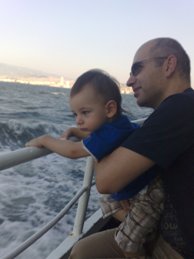| Pages in topic: [1 2] > |
Am I missing a tool or CAT tools fail to deliver? Thread poster: Sebastijan P
|
|---|
Hello!
I hope I have missed this in various tools I use but it seems fascinating to me that no one has implemented this.
What is the issue?
In a multi-user environment when many translators share the same TM and work on the same project, there is no "post-analysis" option to show what the translator actually translated.
Let me explain.
Let's take 2 translators working on 2 files (big files) and one common TM.
I produce... See more Hello!
I hope I have missed this in various tools I use but it seems fascinating to me that no one has implemented this.
What is the issue?
In a multi-user environment when many translators share the same TM and work on the same project, there is no "post-analysis" option to show what the translator actually translated.
Let me explain.
Let's take 2 translators working on 2 files (big files) and one common TM.
I produce analysis for both files before translators begin to translate.
Translators begin to translate and they both send translation units to the TM.
Of course, as they translate, they produce 100% matches (from repetitions) and also a lot of fuzzy matches. The end result is that I cannot see what was translated by who and what kind of fuzzies every translator received from the TM.
And to go on. Having all the information stored in the TM and completely ignoring the "document level" of segments is also quite strange. After all: having revision history in Wikis is not something new.
Your comments?
Kind regards,
Sebastijan ▲ Collapse
| | | |
Selcuk Akyuz 
Türkiye
Local time: 18:27
English to Turkish
+ ...
| Which CAT tool? | Aug 26, 2008 |
PICOW wrote:
I hope I have missed this in various tools I use but it seems fascinating to me that no one has implemented this.
[Edited at 2008-08-26 18:30]
| | | |
Sebastijan P
Slovenia
English to Slovenian
+ ...
TOPIC STARTER
Give me a tool that does that and I'll pay it with gold . .
Kind regards,
Sebastijan
| | | |
Heinrich Pesch 
Finland
Local time: 18:27
Member (2003)
Finnish to German
+ ...
I never do teamwork translation, but in any TM there is the ID and the date and time stamp for every unit.
Regards
Heinrich
| | |
|
|
|
... in both of the tools I use.
| | | |
Jaroslaw Michalak 
Poland
Local time: 17:27
Member (2004)
English to Polish
SITE LOCALIZER | Not really close... | Aug 26, 2008 |
What I describe here is not exactly what you need, but I cannot think of any other solution...
When you translate files in TagEditor, the information about the match level for the opened segment is saved in the relevant ttx file. For example, if a translator opened a segment that had a 50% match in a TM, the segment will be saved with the tag MatchPercent=„50”.
It should be relatively easy to gather that information and calculate it against the source segment wordco... See more What I describe here is not exactly what you need, but I cannot think of any other solution...
When you translate files in TagEditor, the information about the match level for the opened segment is saved in the relevant ttx file. For example, if a translator opened a segment that had a 50% match in a TM, the segment will be saved with the tag MatchPercent=„50”.
It should be relatively easy to gather that information and calculate it against the source segment wordcount (e.g. with a perl script). Of course, this would be a rather rough estimate, especially that the numbers might be significantly skewed by re-editing the same file (e.g. during proofreading). ▲ Collapse
| | | |
Delio Destro 
Canada
Local time: 08:27
English to Portuguese
+ ...
| I dont get it | Aug 26, 2008 |
I can tell who translated what, when and what the match was from any TM produced by any CAT. I have a few issues with the way CATs file away the information and, more to the point, how we should be able to retrieve it outside the CAT environment with a simpler tool. But I have no issue with what is in there.
| | | |
| The information is already present | Aug 26, 2008 |
The information you mention is usually already present - provided you checked the correct options. In Trados, for example, the options to label each TU with the user who created and edited it and the dates and times the TU was used and changed are checked by default. Of course, if you uncheck these options, then this will not work.
There is even a more sophisticated way to go about it, if you want to have more data to work with to finetune your calculations. You can set up text fiel... See more The information you mention is usually already present - provided you checked the correct options. In Trados, for example, the options to label each TU with the user who created and edited it and the dates and times the TU was used and changed are checked by default. Of course, if you uncheck these options, then this will not work.
There is even a more sophisticated way to go about it, if you want to have more data to work with to finetune your calculations. You can set up text fields. The only drawback is that your translators will have to set and use these, so you have to give them very clear instructions and maybe even do some tests with them before commencing work. If you use this solution, you will be able to label TUs indefinitely: add a label for the project name/number, a label for the document title, etc.
Now, I do agree with you that there aren't many means in place to analyse the resulting data and you then need an external tool to be able to analyse it all and make your calculations. In most cases, all you really need is an advanced text editor which can handle tags (our tags here would be the labels appended to each TU). With such tools, in an exported text TM, you can easily have specific tags highlighted, or highlight entire TUs with all the associated data included, then copy only the highlighted part of the document and create a separate TM with it, which you can then run analyses with using your CAT tool. This goes beyond CAT tool use, but if you really need to have such information, I thinmk it's worth exploring.
One such tool you could use is EmEditor, which you can download (30-day trial) at www.emeditor.com. It costs more or less $40. ▲ Collapse
| | |
|
|
|
Sebastijan P
Slovenia
English to Slovenian
+ ...
TOPIC STARTER
Viktoria Gimbe wrote: The information you mention is usually already present - provided you checked the correct options. In Trados, for example, the options to label each TU with the user who created and edited it and the dates and times the TU was used and changed are checked by default. Of course, if you uncheck these options, then this will not work. There is even a more sophisticated way to go about it, if you want to have more data to work with to finetune your calculations. You can set up text fields. The only drawback is that your translators will have to set and use these, so you have to give them very clear instructions and maybe even do some tests with them before commencing work. If you use this solution, you will be able to label TUs indefinitely: add a label for the project name/number, a label for the document title, etc. Now, I do agree with you that there aren't many means in place to analyse the resulting data and you then need an external tool to be able to analyse it all and make your calculations. In most cases, all you really need is an advanced text editor which can handle tags (our tags here would be the labels appended to each TU). With such tools, in an exported text TM, you can easily have specific tags highlighted, or highlight entire TUs with all the associated data included, then copy only the highlighted part of the document and create a separate TM with it, which you can then run analyses with using your CAT tool. This goes beyond CAT tool use, but if you really need to have such information, I thinmk it's worth exploring. One such tool you could use is EmEditor, which you can download (30-day trial) at www.emeditor.com. It costs more or less $40.
I agree that you can set this on TM level (Creation Date, Time, User etc),
but if I want to make analysis of what was translated by who and what match % someone got in HIS/HER file would help me to get accurate analysis results.
So: I have 2 files.
The first has a sentence: "Happy New Year to all"
The second has sentence: "Happy New Year 2008"
2 Translators work on the same TM.
When I make the initial analysis I would get 5 no match words, analysing the second file would give me 4 no match words (separate analysis).
OK.
Translator #1 would be first to translate the sentence (hence translating the real no match), 5 minutes after the translator #1 the translator #2 would come across his sentence. He would of course get a fuzzy match from the translator #1 and would delete "to all" typed 2008 and would be on his merry way.
Now.
How can I "see" that translator #2 never translated the whole sentence but translated this sentence with a fuzzy from translator #1?
Sorry for the rather primitive illustration . .
Kind regards,
Sebastijan
| | | |
| Multiple TMs in one project | Aug 26, 2008 |
This might be a step in the right direction, not really sure whether it actually brings the solution though:
There are CAT tools that allow simultaneous use of multiple TMs in one project (e.g. MemoQ or DVX Workgroup). So if you set the settings in a way that one translator fills "his" TM, while being able to read and use the other translators' TMs, and later use one TM at a time to analyse, would that help? Of course there would have to be a way to prevent the translator from actua... See more This might be a step in the right direction, not really sure whether it actually brings the solution though:
There are CAT tools that allow simultaneous use of multiple TMs in one project (e.g. MemoQ or DVX Workgroup). So if you set the settings in a way that one translator fills "his" TM, while being able to read and use the other translators' TMs, and later use one TM at a time to analyse, would that help? Of course there would have to be a way to prevent the translator from actually transfering exact matches from the other TMs into his own TM. AFAIK, both MemoQ and DVX Workgroup have the option to check a segment as "done" (which means that it is entered into the TM). The translator should be instructed not to use this option in case of an exact match or a repetition.
In DVX, you could then take a seperate look at all fuzzy matches within a project and you could look up who translated what (AFAIK, this is not possible in MemoQ, because there is no row selector as in DVX). Still, if you want a full-featured statistics function, I will have to regret on that one. ▲ Collapse
| | | |
It's a bit clearer to me where you're going with this. I'm however sorry to say that that may be a way you don't want to go. Here's why.
What if the first translator translated that first segment wrong, or with a typo, or something of the sort? The second translator will then not only need to translate that Happy New Year segment entirely, but will also need to correct the first, wrong segment translated by the first translator - all while being paid much less. This can cause a lot ... See more It's a bit clearer to me where you're going with this. I'm however sorry to say that that may be a way you don't want to go. Here's why.
What if the first translator translated that first segment wrong, or with a typo, or something of the sort? The second translator will then not only need to translate that Happy New Year segment entirely, but will also need to correct the first, wrong segment translated by the first translator - all while being paid much less. This can cause a lot of trouble, because if you pay the second translator less, s/he just might pretend s/he didn't see the mistake made by the first translator, since that would only take away from his/her hourly revenue. Imagine the quality in the end!
In any case, several translators working on the same TM simultaneously is not meant to be a means for clients to make more profit, but rather a means to ensure that the quality is consistent throughout. ▲ Collapse
| | | |
| Do you know Star Transit? | Aug 27, 2008 |
Transit gives you the exact type of post-translation analysis you are looking for.
The only thing I don't know is whether it allows TM sharing the way you described.
(I always use the Satellite version, the client sets up the project in the full version and I work myself.)
On another note, I always get paid based on the import statistics, and flat refuse to be paid based on the post-analysis statistics. (I can give you more details later, why, if you want.)
... See more Transit gives you the exact type of post-translation analysis you are looking for.
The only thing I don't know is whether it allows TM sharing the way you described.
(I always use the Satellite version, the client sets up the project in the full version and I work myself.)
On another note, I always get paid based on the import statistics, and flat refuse to be paid based on the post-analysis statistics. (I can give you more details later, why, if you want.)
By the way, there is a risk in the process you described. When I translate, I often go back to previous sentences to make changes, mainly for consistency, or because something that was ambiguous first, became clear 2 chapters later... So, I constantly revise stuff, and when I am through with the whole file, I proofread it - means more corrections.
In the kind of real-time sharing you described, you would assume that the translation is right at the first time, otherwise it would be risky to use it in another file by another person, right? If person A modifies the sentence that was used by person B either as a 100% or a fuzzy match, the sentence in B's file will need to be revised as well. How do you work around this situation?
P.S: Meanwhile I was typing this, Victoria posted her similar comment about the problems with real-time TM sharing. I did not see that before I wrote mine.
[Edited at 2008-08-27 04:37] ▲ Collapse
| | |
|
|
|
| Not all CAT tools have the same approach to TM as such | Aug 27, 2008 |
Transit does not (primarily) have a TM we know in Trados. If I simplify a bit, you can have 100 files translated from English to Czech, and when a new project comes, you chose which files out of your "old hundred" are to be used as reference - so you can easily choose a "flexible ad hoc TM" depending on your project.
There are various options to simplify your work. For example, you can make an "extract" of any number of translated files into one (which helps if there are many segmen... See more Transit does not (primarily) have a TM we know in Trados. If I simplify a bit, you can have 100 files translated from English to Czech, and when a new project comes, you chose which files out of your "old hundred" are to be used as reference - so you can easily choose a "flexible ad hoc TM" depending on your project.
There are various options to simplify your work. For example, you can make an "extract" of any number of translated files into one (which helps if there are many segments shared among them) - the outcome is then something like the Trados TM. Or you can have a string of projects, each "new one" uses as reference the preceding one and all files before it (and have a "contract string", "automotive string", etc.)
Of course the "attributes" (who, when, etc. translated a particular segment) are saved as well.
I am going into this level of details only to show that the "TM concept" of Trados need not be the only one.
Antonin ▲ Collapse
| | | |
Samuel Murray 
Netherlands
Local time: 17:27
Member (2006)
English to Afrikaans
+ ...
| Using WF, and a little macro | Aug 27, 2008 |
PICOW wrote:
How can I "see" that translator #2 never translated the whole sentence but translated this sentence with a fuzzy from translator #1?
So, you wish to have a record of which segment was translated by which translator, and which segment was translated after a match was proposed, and who the translator of the proposed segment was, right?
If you can write a macro in MS Word, you may be able to get this out of Wordfast. WF doesn't have this feature exactly, but in WF you can display the proposed match's attributes during translation. If you can write a macro to copy the attributes from that view and somehow paste it in the purple text that accompanies every segment, you'll have a record in bilingual format of it.

It would be interesting to know if it would be possible to add a reduced version of the match's attribute as an additional attribute to the current segment's TU, so that you'll have the information in TM format in addition to having it in bilingual RTF format.
| | | |
Sebastijan P
Slovenia
English to Slovenian
+ ...
TOPIC STARTER | it's an argument, but .. | Aug 27, 2008 |
Viktoria Gimbe wrote:
It's a bit clearer to me where you're going with this. I'm however sorry to say that that may be a way you don't want to go. Here's why.
What if the first translator translated that first segment wrong, or with a typo, or something of the sort? The second translator will then not only need to translate that Happy New Year segment entirely, but will also need to correct the first, wrong segment translated by the first translator - all while being paid much less. This can cause a lot of trouble, because if you pay the second translator less, s/he just might pretend s/he didn't see the mistake made by the first translator, since that would only take away from his/her hourly revenue. Imagine the quality in the end!
In any case, several translators working on the same TM simultaneously is not meant to be a means for clients to make more profit, but rather a means to ensure that the quality is consistent throughout.
Hi Viktoria!
Thank you for your reply.
I agree that this is of course an issue not to be overlooked. That is why I am saying that CAT tools need to evolve much faster to keep up with the industry. Just to make one thing clear: I am first and foremost a translator and I am OK with the tools I use for freelance projects. Being a translator I try to avoid measurements unfair for translators.
What concerns retranslating translation from other translators I agree, it's a question. BUT. That is exactly why we need BETTER revision tracking. Revision tracking would enable to have a better overview of what was going on at the particular segment and also would give a better insight that translator #2 did more than just completing a fuzzy match that came from translator #1.
And with team translation we/you need better tracking and an analysis system that would be more fair for translators and more effective for, let's say a LSP.
I have been testing MemoQ and it seems it is the closest to the needs of team translation, especially for terminology and segment commenting and changing status of the segment. It is missing a few key components, though.
Kind regards,
Sebastijan
| | | |
| Pages in topic: [1 2] > |























